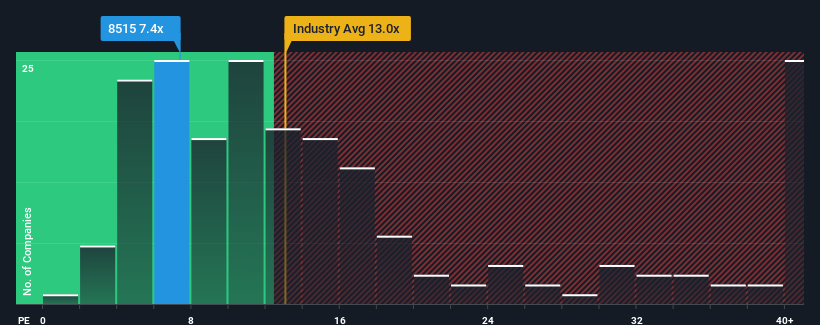- Japan
- /
- Consumer Finance
- /
- TSE:8515
Aiful Corporation's (TSE:8515) Shares Lagging The Market But So Is The Business
Aiful Corporation's (TSE:8515) price-to-earnings (or "P/E") ratio of 7.4x might make it look like a buy right now compared to the market in Japan, where around half of the companies have P/E ratios above 13x and even P/E's above 20x are quite common. Nonetheless, we'd need to dig a little deeper to determine if there is a rational basis for the reduced P/E.
Our free stock report includes 1 warning sign investors should be aware of before investing in Aiful. Read for free now.Recent times have been advantageous for Aiful as its earnings have been rising faster than most other companies. It might be that many expect the strong earnings performance to degrade substantially, which has repressed the P/E. If you like the company, you'd be hoping this isn't the case so that you could potentially pick up some stock while it's out of favour.
View our latest analysis for Aiful

How Is Aiful's Growth Trending?
In order to justify its P/E ratio, Aiful would need to produce sluggish growth that's trailing the market.
Taking a look back first, we see that the company managed to grow earnings per share by a handy 13% last year. EPS has also lifted 10% in aggregate from three years ago, partly thanks to the last 12 months of growth. Therefore, it's fair to say the earnings growth recently has been respectable for the company.
Looking ahead now, EPS is anticipated to climb by 7.2% during the coming year according to the four analysts following the company. Meanwhile, the rest of the market is forecast to expand by 9.5%, which is noticeably more attractive.
With this information, we can see why Aiful is trading at a P/E lower than the market. Apparently many shareholders weren't comfortable holding on while the company is potentially eyeing a less prosperous future.
The Key Takeaway
Using the price-to-earnings ratio alone to determine if you should sell your stock isn't sensible, however it can be a practical guide to the company's future prospects.
As we suspected, our examination of Aiful's analyst forecasts revealed that its inferior earnings outlook is contributing to its low P/E. At this stage investors feel the potential for an improvement in earnings isn't great enough to justify a higher P/E ratio. Unless these conditions improve, they will continue to form a barrier for the share price around these levels.
Having said that, be aware Aiful is showing 1 warning sign in our investment analysis, you should know about.
If these risks are making you reconsider your opinion on Aiful, explore our interactive list of high quality stocks to get an idea of what else is out there.
New: Manage All Your Stock Portfolios in One Place
We've created the ultimate portfolio companion for stock investors, and it's free.
• Connect an unlimited number of Portfolios and see your total in one currency
• Be alerted to new Warning Signs or Risks via email or mobile
• Track the Fair Value of your stocks
Have feedback on this article? Concerned about the content? Get in touch with us directly. Alternatively, email editorial-team (at) simplywallst.com.
This article by Simply Wall St is general in nature. We provide commentary based on historical data and analyst forecasts only using an unbiased methodology and our articles are not intended to be financial advice. It does not constitute a recommendation to buy or sell any stock, and does not take account of your objectives, or your financial situation. We aim to bring you long-term focused analysis driven by fundamental data. Note that our analysis may not factor in the latest price-sensitive company announcements or qualitative material. Simply Wall St has no position in any stocks mentioned.
About TSE:8515
Aiful
Engages in the consumer finance and credit guarantee business in Japan.
Undervalued with adequate balance sheet.
Market Insights
Community Narratives




